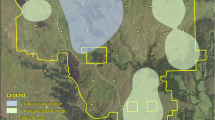Synopsis
The spatial distribution, seasonal abundance and diel activity of four sticklebacks,Gasterosteus aculeatus, G. wheatlandi, Pungitius pungitius, andApeltes quadracus. coexisting in a St. Lawrence salt marsh were examined to see how these closely related species share their habitat. While all four species breed in the Riviè des Vases, a tidal creek, only three species are found in the adjacent salt marsh pools,A. quadracus being absent. Results are interpreted in terms of avoidance of interspecific competition for space during the relatively short breeding season at this latitude.
Similar content being viewed by others
References cited
Coad, B. W. & G. Power, 1973. Life history notes and meristic variation in the fresh water four spine stickleback,Apeltes quadracus (Mitchell), near Sept-Isles, Quebec. Naturaliste can. 100: 247–251.
Girsa,I. I. 1975. The diurnal feeding rhythm in the feeding of underyearlings of some White Sea fish at different photoperiods. J. Ichthyol. 102–109.
Kirk, R. E. 1968. Experimental design: procedures for the behavioral sciences. Brooks & Cole Publishers, Belmont. 577 pp.
Lambert, Y. & G. FitzGerald. 1979. Summer food and movements of the Atlantic tomcodMicrogadus tomcod (Walbaum) in a small tidal creek. Naturaliste can. 106: 555–559.
Lavoie, R & G. Beaulieu. 1971. Salinité des eaux de surface du St-Laurent. Naturaliste can. 98: 191–193.
Manzer, J. I. 1976. Distribution, food and feeding of the threespine stickleback. Gasterosteus aculeatus, in Great Central Lake, Vancouver Island, with comments on competition for food with juvenile sockeye salmon,Oncorhrnchus nerka. U.S. Fish Bull. 74: 647–668.
Nelson, J. S. 1968. Salinity tolerance of brook sticklebacks.Culaea inconstans, freshwater ninespine sticklebacks,Pungitius pungitius and freshwater four spine sticklebacks,Apeltes quadracus. Can. J. Zool. 46: 663–667.
Reed, A. & G. Moisan. 1971. TheSpartina tidal marshes of the St. Lawrence estuary and their importance to aquatic birds. Naturaliste can. 98: 905–922.
Rowland, W. J. 1970. Behavior of three sympatric species of sticklebacks and its role in their reproductive isolation. Ph.D. thesis. State University of New York at Stony Brook. 170 pp.
Sale, P. F. 1978. Habitat partitioning and competition in fish communities. pp. 323–331. In: R. H. Stroud & H. Clepper (ed.) Predator-Prey Systems in Fisheries Management. Sport Fishing Institute, Washington D.C..
Wootton, R. J. 1976. Biology of the sticklebacks. Academic Press, London. 387 pp.
Author information
Authors and Affiliations
Rights and permissions
About this article
Cite this article
Worgan, J.P., FitzGerald, G.J. Habitat segregation in a salt marsh among adult sticklebacks (Gasterosteidae). Environ Biol Fish 6, 105–109 (1981). https://doi.org/10.1007/BF00001804
Received:
Accepted:
Issue Date:
DOI: https://doi.org/10.1007/BF00001804




